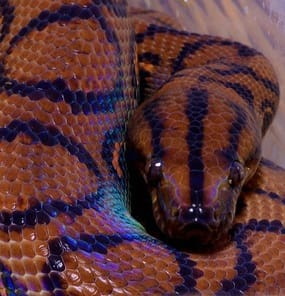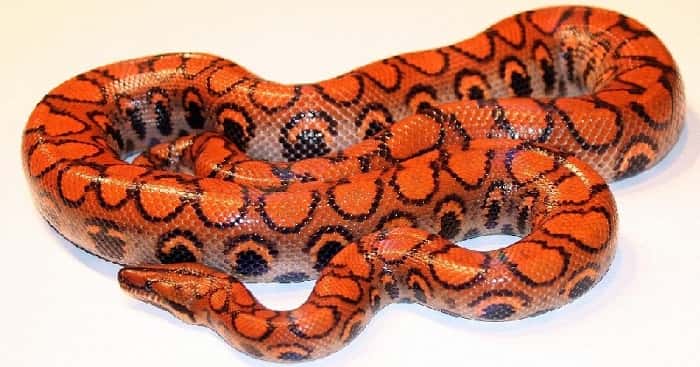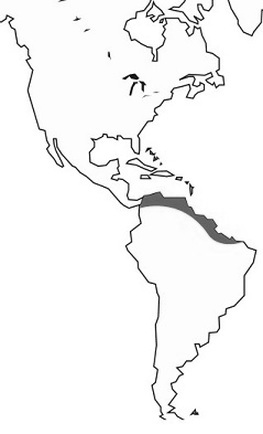Brazilian Rainbow BoaEpicrates cenchria cenchria |

Custom Search
|
Rainbow boas are members of the Boidae family, which includes about 40 other species like the boa constrictor or the Amazon rainforest giant snake the green anaconda. All boas are considered primitive snakes, because they still display vestigial hind limbs as small spurs on both sides of the cloaca.
These primarily terrestrial snakes are usually found near water, they inhabit rainforest, humid woodland forests but can also sometimes be found in open savannas. They do have a prehensile tail to help them climb, but they are not truly arboreal snakes. The Brazilian rainbow boa is a medium size species, with a round body boa ranging in length from 4 to 6 feet (1.2 - 1.8 m) and weighing 2 or 3 lbs. Females grow larger than their male counterparts. Although not especially large their head is distinctly wider than the neck with 3 parallel black stripes. There is a great variation in both color and pattern among these snakes. They have a soft and beautiful iridescent skin, hence their common name, rainbow boas. Just after shedding its scales become even more iridescent. The Brazilian rainbow boa is brown or reddish-brown, with large black dorsal blotches down the back. They are considered by many as the world’s most beautiful snake, although I would consider one other species a real contender for this title, the green tree python or even the emerald tree boa. The species is also known as the slender boa or simply rainbow boa. Because of their beautiful iridescent skin, the Brazilian rainbow boa is a very popular species within the exotic pet trade. Since this species needs a high humidity environment, they are regarded as an intermediate or difficult snake to keep in captivity. These boas are readily available at exotic pet stores, or local reptile shows with several morphs available. When they are younger they are more prone to bite due to natural defense instincts, but as they become more used to handling tend to calm down. Like other species, the young Brazilian rainbow boas are probably preyed upon by birds of prey, small mammals or other reptiles. Their lifespan in the wild is estimated to be around 10 years, but in captivity, the species may live up to 30 years.

Diet / Feeding
In the wild, the Brazilian rainbow boa feeds on small mammals, rodents, birds and their eggs, lizards, and frogs. In captivity, they eat mice and rats. These snakes are mostly terrestrial and nocturnal, they will actively search for prey in their environment using the heat sensing pits present on its jaw to help locate prey in the dark. They are non-venomous snakes and like other boas, they ambush and constrict their prey. Grabbing their prey with their very sharp and backward facing teeth, coiling around it and squeezing the prey with their muscular body. Reproduction The Brazilian rainbow boa is an ovoviviparous species, meaning the hatchlings develop in egg sacks inside the female's body, they also hatch inside but are born alive. The breeding season occurs from November to January, with the average clutch ranging from 12 to 25 hatchlings. The gestation period lasts about 5 months. The young snakes get no parental care and will begin hunting for small rodents in a week. The young snakes are born around 15 to 20 inches (38 - 50 cm) long, and within a year they reach 36 to 40 inches (91 - 101 cm) in length. The Brazilian rainbow boa sexual maturity like many other snake species is determined not by age but rather by individual length. Females reach this stage at around 4.5 feet (1.4 m), males need only a little less at about 4 feet (1.2 m). Conservation / Threats The Brazilian rainbow boa has not yet to be assessed for the IUCN Red List. They are still considered a common species in most parts of their range. It's also listed in CITES Appendix II. But like many other snake types, their future is threatened by human encroachment and habitat destruction. On the other hand rather than killing these beautiful snakes indigenous people encourage them to live around their villages to help controlling rodent populations, which may spread diseases or attack crops. In the 1980’s and early 90's, the species was heavily exploited for the pet trade. At this time probably hundreds if not thousands of Brazilian rainbow boas were collects from the wild and exported for sale particularly from Suriname.
|
Scientific Classification |
© 2014 Snake Facts About Us | Privacy Policy | Contact




